Last Saturday, Michael Jennings, Rob Fisher and I went to the Farnborough Airshow, to which, of course, we all brought our cameras. The one with the cheapest and cheerfullest camera tends to take the most pictures, (a) because the pictures tend to be smaller and will fit with ease onto today’s infinite SD cards no matter how many you take, and (b) because with a cheap and cheerful camera you want to give yourself lots of chances to have taken some good snaps, in among the torrent of bad ones. So I took the most photos. There follows a very small selection of these compared to how many I took, and a very large selection compared to how many photos there usually are in Samizdata photo-essays. In the event that you would like to see any of them bigger, click on them. They are shown in chronological order.
Rob’s photos can be seen here. They include quite a few that show what it was like arriving. Rather chaotic, and aesthetically shambolic, in a way that really doesn’t suggest a great show of any sort. Farnborough only happens every two years, and I guess it just isn’t worth organising all the incidentals associated with the public descending on the place for just one weekend every two years, any better than only just adequately. The train from Waterloo (they’re very frequent) having taken about forty minutes (I bought a train-and-bus-included ticket to the show at Waterloo), there was then a satanically convoluted bus journey from Farnborough railway station, smothered in traffic jams of people trying to get to the same spot in their cars, a journey that caused us, in the evening, to prefer to take the same journey back to the station on foot. But we finally arrived at the airfield, where there was yet more too-ing and fro-ing, this time along improvised queue routes, bounded by temporary barriers such as you get around roadworks. We were herded along these tracks and into the show by men in flourescent tops shouting at us. Is this what pop festivals are like?
Mercifully soon we were in, and wandering past further aesthetic shambles, in the form of closely bunched exhibits with euphemistic signs on them about “all your force projection needs” (calling in an air strike when you get into a fight outside a pub?), “delivering ordnance efficiently” (killing people efficiently), “creative solutions” (killing people creatively), “mission specific solutions” (killing exactly the people you want to kill in exactly the way you want to kill them) and so on. Fair enough. The truth is too horrible to be faced head on.
Here was my favourite of these preliminary exhibits:
It’s this. Looks like a whale, doesn’t it? The twenty first century looks like being a golden age of unmanned flight. Who would have thought that model aircraft would turn into a grown-up industry?
Then on to join the main throng next to the runway, to confront sights like this:
This was the moment when I began to fear that I would be without food or water for the next six, hot hours. I could see lots of people, with their own picnic equipment, and lots of other guys with cameras. I could see a big runway, and distant hangers and airplanes. But what if I starved to death? I postponed such thoughts, because just as they were occurring to me, the main show (scroll down to Saturday 24th to see what we saw) was getting under way.
Item one, which I was really looking forward to seeing close up, having already photoed it from far below and far away, in central London, was this:
The A380 did a slow motion impersonation of a plane doing trick flying, going up too steeply and then down too steeply, and then tilting itself too steeply and cornering too much, all with the stately grace of the white elephant that I assume it to be. Beautiful. Then, a real show of trick flying, by these characters:
There was much falling out of the sky leaving a trail of smoke, and at one point they did synchronised falling out of the sky leaving two near identical trails of smoke, to prove that they were doing exactly what they intended, rather than just letting it happen of its own accord. I was impressed:
Then came another giant, one of the dominant airplanes, indeed one of the dominant world facts, of the last half century:
That’s the first time in my life I’ve seen a B52 in the flesh, so to speak. The surprise to me there is the fuselage. The B52, from that angle and in my distinctly approximate photo, looks like a wooden toy made by a super-dad in the garage for his small son, small son being too small to care that the fuselage is so unrealistic. A bit of sculpting under the rear, and at the front of course, but otherwise, just a length of broom handle, an effect greatly enhanced by the sawn-off look at the back. Real airplanes don’t look like that!
World War 2 relics were much in evidence. Yah boo hiss!:
Hurrah!:
Also present were modern jet fighters. Trouble is, they take off so damn fast that they are a dot next to a cloud before you (by which I mean I) have realised they are even performing. The noise they make when they do take off is: noisy. The unprepared brain (by which I mean my brain), when subjected to this noise, does not make decisions any better or any faster. Here is an American F something doing its thing:
There came a moment when all those zoom lenses suddenly pointed straight upwards, without any moving about, and I snapped all the vertical zoom lenses for a while before I became curious about what they were pointing at. Parachutes! Again, much smoke, but also a union jack:
Foreigners, I instinctively assumed, sucking up to us. But then I thought, maybe not. Maybe here, the union jack is not apologised about by anyone.
There was a World War 1 show, involving lovingly preserved relics such as this:
There was another F something from America:
The World War 2 relics took to the air, thus:
And thus:
Owing to its implausibly shiny black paint, and my camera’s habit of freezing all moving propellers into immobility, the Avro Lancaster looked like an assembled Airfix plastic kit, hanging from a kid’s bedroom ceiling (i.e. my bedroom ceiling), circa 1965:
Then a “Typhoon”. I was expecting an unwieldy mid-forties propeller-driven job, but it turned out to be this:
Again, it was a dot in the clouds by the time I clocked that it was even in the sky. Luckily it has a distinctive sillhouette, and luckily it did come back, but it never got as close to me again as when it was taking off.
Then this:
Photographing the Farnborough Airshow really well is a skill like any other, one which I do not really possess, what with this being my first visit since I was about six, and my absolute first with a camera. But if you can’t get at least some good snaps at Farnborough you are really not much of a photographer, and it you can’t get some good snaps of the Red Arrows, you are beyond photographic hope. I got some good shots of them:
I also got shots with red white and blue smoke, and less effective shots of Red Arrows suddenly charging madly off in all directions from one red, white and blue spot, many of them right out of my picture, and of two Red Arrows nearly but not colliding, none of them snapped at the exact right moment. Anyone who wants to see all the regular Red Arrow pictures has seen them. I felt I needed a different slant on the Red Arrow phenomenon:
We saw several of those.
So, it’s the second last slot, between the Red Arrows, and the final grandstand finish. What do you shove in there? Answer, a really boring airplane – on its own, no smoke, no loud noises, no nothing, not even the outside chance of a collision – doing really boring aerobatics. Had I encountered such airplane behaviour on some other expedition, say to a London suburb, and had that been the only aerial oddity I spied that month I might have been very impressed. As it was, yawn:
And then, finally, the very much not-yawn Avro Vulcan:
Okay not much of a snap, but by then I was seriously tired. In any case the www is awash with state-of-the-art vulcanography.
And that was that. I’ve missed out quite a few performers. There were various helicopters, and a couple of transport planes taking it in turns to do their party tricks. The second was a Hercules, but we felt it was upstaged by the previous and smaller Italian plane. There was a Catilina flying boat. There were surely others that I’ve forgotten. But it was a good show.
Nor did I starve or die of thirst. On the contrary, the many food and drink stalls along most of the length of the public area did thriving business, providing expensive but eloquent lessons in the Austrian theory of the subjectivity of value. Ice cream on Westminister Bridge? Pass. Same ice cream at 5 pm at a hot and sunny Farnborough Airshow? A bargain at twice the price, in other words: a bargain.
It all seemed very safe. When I was a child, I can remember there being a huge crash at Farnborough, with lots of spectators killed, sadly involving a de Havilland airplane. Since which drama the planes have been forbidden to go anywhere too near to the spectators. No chance of anything like that happening now. Or this. Although I’m sure the reason all we spectators now take such safety for granted is that the flyers themselves never do.
I suspect that in two years time it will all be much the same. The same revered and two-years-older planes from the history books, the same kind of more recent jets doing the same kinds of tricks, spectacularly or solemnly depending on their size and demeanour. I think I’d like to go back in about ten years time, to see if and how things have changed by then. Hope I can.
I would sum the day up as great fun, and great to do in good company rather than alone. So deepest thanks Michael and Rob, without whose promptings such a trip would never even have occurred to me. But it was hard work for me to be at, what with the heat and there being nowhere to sit comfortably. But it was unreservedly great to have been at, although even as I finish this piece the skin is peeling off my stinging, lobster-coloured cheeks and forehead.
The biggest plus about Farnborough is that you can see most of what is on offer from anywhere. You don’t have to hack your way to the front of the throng to get a view of the aerial performers, which means that everyone is relaxed and unpushy and friendly. You just have to look upwards, from wherever you happen to be. Which is a good approach to adopt towards life in general, I think.



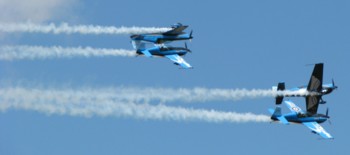
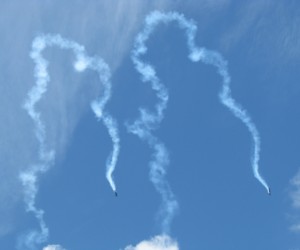
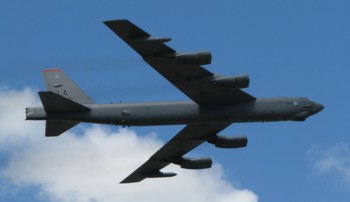


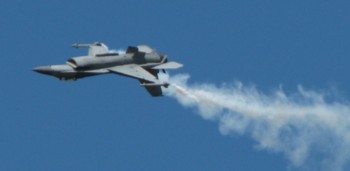
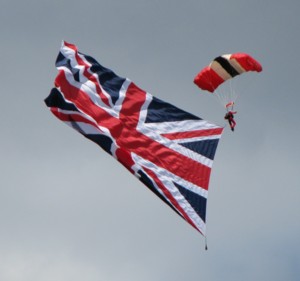
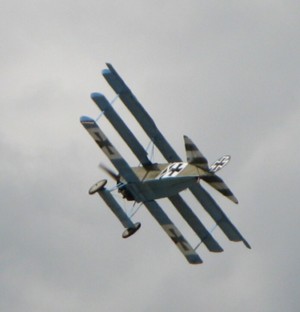
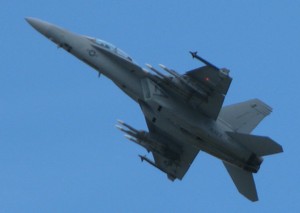
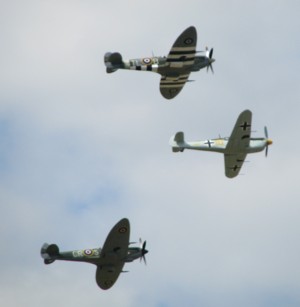







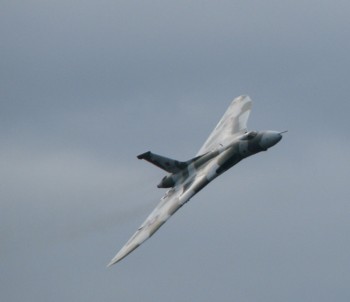




Just in case you wanted to know (and show off my spotterish knowledge): The first F-something is an F-16 Fighting Falcon (though as everyone agrees that’s a crap name they actually call it the “Viper”). The second F-something is an F/A-18F Super Hornet (actually called the “Rhino” to avoid confusing it with the not-super Hornet, which itself is often called the “Bug”).
I have never previously noticed how much the British symbol on their aircraft looks like a bulls-eye target to home in on. Perhaps that part needs to be changed? The temptation is incredible!
I personally like your photograph of the Vulcan.
I like the feeling of it’s lightness, almost weightless as it banks and the very Englishness of the clouds and sunlight in clear air.
In two years I hope to take my son to Farnborough. He will be 4 1/2.
“Real airplanes don’t look like that!”
Aeroplane, aeroplane – please!
“a satanically convoluted bus journey from Farnborough railway station, smothered in traffic jams of people trying to get to the same spot in their cars”
I avoided this by arriving by motorcycle. I offered to take Brian home pillion but for some reason he wasn’t keen.
I was only ever once at an airshow, at Greenham Common over 30 years ago (in pre-missile days).
Then, as now, there was a fly-past by a Lancaster, and my photos also managed to freeze the propellors. The problem comes – as I later realised – from having too fast a shutter speed.
So if your camera allows any adjustment, set the shutter speed for 1/60th or 1/125th, and adjust the aperture accordingly.
Good luck!
I can get very boring about Farnborough since I have lived here on and off for most of my life. When I was a kid I went to the show every year and even now when I hear the fast jets winding up I have to rush to a window to watch.
Farnborough is one of the key airshows for the industry. It lasts a week and the first five days are dedicated to business where everything from a A380 to a new airline seat tray fitting is sold. Each show there are fewer and fewer new aircraft and more and more vintage stuff. Instead of several new aircraft evey year, these days you’re lucky to get a new aircraft every ten years.
Not that I mind watching Spitfires and Hurricanes or Vulcans and Buffs flying about, but I’ve decided that I won’t bother going to the show again until they have the Virgin Galactic craft flying around. Maybe they can offer ‘trips round the bay’.
Incidentally, it was a DH110 that broke up when the pilot, John Derry, took it through the ‘sound barrier’ for the second time. They named a nearby road for him.
Instead of several new aircraft evey year, these days you’re lucky to get a new aircraft every ten years.
The new aircraft that I was at the show and that I wanted to see was the Boeing 787, but alas it was only present on some of the trade days. I understand Boeing’s issues given that the aircraft is two years late in production and they want to get it back to testing, but it still would have been nice to see. Similarly, the F-22 flew on trade days but not the public days, and although it was nice that the USAF sent a B-52 over when I was there, the F-22 is much more new and interesting.
This is not really meant as a complaint, but a regret. Next time I might come on the Tuesday and spend the day in that pub at the end of the runway with the large beer garden.
Come to Thunder over Michigan August 7th and 8th at Willow Run and see how an air show should be organized.
You’ll see the largest group of flying B17’s that can be assembled in one place, as well as a whole slew of other aircraft, ancient and modern. As an added bonus, see whether you can spot llamas in the crowd, probably on the Saturday. I have a connection with one of this year’s spronsors so we have free passes, yippee!
The last time I went to Farnborough, more than 30 years ago,, it was a disorganized shambles the like of which only the Brits can achieve. It sounds like nothing has changed. Apparently, wasted time, chaos, discomfort and a general air of ‘roughing it’ are an intergal part of the full enjoyment of any UK public event.
llater,
llamas
I’d love to see an old B47 flown prior to the B52, and amazing as the F-22 is, I’ll still go to see F-16s even if they’re just standing around not flying.
Hector Plasm,
The Wright Brothers invented it and called it an airplane. We should honour the Bishop’s boys and do the same.
One point about the B-52, on which I was a crew dog many years ago: the correct nickname/acronym is ‘BUF,” not “BUFF” as a prissy USAF would have you believe. It stands for ‘Big Ugly Fornicator’ (more or less).
‘Big Ugly Fat Fellow’, forsooth!
Your thoughts and good wishes, please, for Jack Roush, ‘the cat in the hat’, who was seriously injred in a plane crash at Oshkosh the other day. Mr Roush owns and flies P51’s as well a a slew of other historical airplanes, he rebuilds aircraft Merlins as a losing venture to keep these planes flying, and he is generally a great friend to historical and experimental aviation.
http://www.foxnews.com/sports/2010/07/29/cup-roush-remains-hospitalized/
llater,
llamas
Mike Borgelt- sorry, you are wrong. In the great book, “This Little Britain”, by Harry Bingham, he lists the many fields in which Britain was first. Baronet Sir George Cayley wrote the first treatise on Aerodynamics in 1810. Then he built the world’s first aeroplane, which we would call a glider. He ordered his coachman into it, and it successfully flew for 500 yards, and the coachman was not killed when it landed!
The Wright brothers added an engine to their craft, yes, and made wonderful innovations, but we’d had gliders before them.
And didn’t Leonardo da Vinci also write about gliding and flight? He might have been the first to look at it seriously- so what did he call his craft? Maybe that should be what we call it!
Also, my dictionary has ‘aeroplane’, and ‘aircraft’, as words, but not ‘airplane’. ‘Aeroplane’ means an aircraft with wings and at least one engine to propel it, whilst aircraft also covers everything else, gliders, balloons, etc.
This online dictionary has “airplane”, “aeroplane”, and “aircraft” as synonyms (with “airplane” being the first version used). And it’s not the only one to define “airplane”. Any of these terms is acceptable; neither of you is incorrect. So get off it.
For various reasons we get a fair amount of 787 traffic around here at the moment. To be honest, it doesn’t turn the head all that much – from a distance you’re hard pressed to notice it’s different from other panes because you can’t really see the nose.
The last time I saw it up close they were doing a low engine power low level landing test and it sounded like it was about to fall apart. But that’s what flight tests are for.
Very nice photoblog entry, Brian. I love airshows.
The first American F-something is an F-16 Falcon
the second is an F-18E/F Super Hornet (the Super Hornet has trapezoidal intakes and the A-model regular Hornet has round intakes). The E is the single seater, the F is the two seater that is usually used only for training or giving rides to dignitaries or other VIPs.
The B-52 is ugly, yes. We call it the BUFF (its official name is the Stratofortress), which stands for Big Ugly Fat Frakker. It is noted for flying with a negative angle of attack, which is both intimidating and easily scares you on the ground into thinking its gonna crash.
I homed in on the reference to Airfix circa 1965. Add a couple of years to that and you get to the Airfix phase of my misspent childhood.
I still vividly remember an improbable construction that on the box said it was a Blohm und Voss, or thereabouts, which my friends immediately admired as a “blomming voss”. The odd thing about it was that it was laterally asymmetrical to the point of grotesqueness. Like, engine nacelle on one side, crew on the other, with a bit of wing inbetwixt sort of thing. You hardly needed telling that only perfidious Jerry could have dreamt of making something like that. I am not aware that the monster ever flew, though.
Blom & Voss were famous for their asymmetrical designs, a few of which like the BV-141 made it into production.
Drat. Blohm & Voss.
Brian,
Got to see a Vulcan at Abbotsford some decades ago. The low-speed fly-by with the gear down and the bomb bay doors open was incredible; the most profound conversion of jet fuel to noise I have ever witnessed. 🙂
Mike,
Are there any flying B-47s?
Nope.